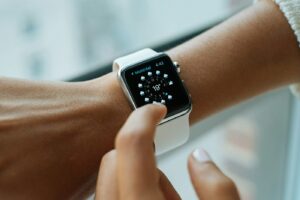Wearable technology has come a long way since the introduction of the first fitness trackers and smartwatches. Today, wearables are not just gadgets; they’re powerful tools that integrate seamlessly into our lives, enhancing health, productivity, and connectivity. As we look ahead, the future of wearable technology promises even more exciting innovations. In this blog, we’ll explore the top trends shaping the future of wearables and how they’ll impact our daily lives.
1. Health Monitoring Goes Beyond Fitness
Wearables are evolving from simple step counters to advanced health monitoring devices.
- Key Trends:
- Continuous Glucose Monitoring (CGM): Non-invasive glucose tracking for diabetics.
- Blood Pressure Monitoring: Real-time blood pressure tracking without a cuff.
- ECG and Heart Health: Wearables like the Apple Watch already offer ECG capabilities, but future devices will provide even more detailed insights.
- Mental Health Tracking: Monitoring stress levels, sleep patterns, and emotional well-being.
- Impact:
These advancements will empower users to take proactive control of their health, potentially reducing the need for frequent doctor visits.
2. Augmented Reality (AR) Glasses
AR glasses are set to revolutionize how we interact with the world.
- Key Trends:
- Apple Vision Pro: Apple’s entry into the AR space promises immersive experiences for work and entertainment.
- Meta Smart Glasses: Meta is working on AR glasses that integrate with its metaverse vision.
- Enterprise Applications: AR glasses for industries like healthcare, manufacturing, and education.
- Impact:
AR glasses will blur the line between the physical and digital worlds, enabling new ways to work, learn, and play.
3. Smart Clothing
The next frontier in wearables is smart clothing—apparel embedded with sensors and technology.
- Key Trends:
- Biometric Tracking: Shirts and leggings that monitor heart rate, muscle activity, and posture.
- Temperature Regulation: Jackets that adjust to weather conditions.
- Haptic Feedback: Clothing that provides tactile feedback for gaming or navigation.
- Impact:
Smart clothing will make wearables even more discreet and integrated into our daily lives.
4. Wearables for Mental Health
Mental health is becoming a key focus for wearable technology.
- Key Trends:
- Stress and Anxiety Monitoring: Devices that track cortisol levels and stress indicators.
- Mood Tracking: Wearables that analyze speech patterns and physiological signals to assess mood.
- Guided Meditation and Breathing Exercises: Integration with apps like Calm and Headspace.
- Impact:
These innovations will help users manage stress and improve mental well-being.
5. Extended Battery Life and Energy Harvesting
Battery life remains a challenge for wearables, but new technologies are on the horizon.
- Key Trends:
- Solar-Powered Wearables: Devices that charge using sunlight.
- Kinetic Energy Harvesting: Charging through body movement.
- Improved Battery Efficiency: Longer-lasting batteries with faster charging.
- Impact:
These advancements will make wearables more convenient and sustainable.
6. Wearables for Elderly Care
As the global population ages, wearables will play a crucial role in elderly care.
- Key Trends:
- Fall Detection: Devices that alert caregivers in case of a fall.
- Medication Reminders: Wearables that ensure timely medication intake.
- Remote Health Monitoring: Real-time tracking of vital signs for seniors.
- Impact:
These wearables will enable seniors to live independently while ensuring their safety and well-being.
7. Integration with the Internet of Things (IoT)
Wearables will become a central hub for IoT devices.
- Key Trends:
- Smart Home Control: Wearables that interact with smart home devices like lights, thermostats, and security systems.
- Seamless Connectivity: Integration with cars, appliances, and other IoT-enabled devices.
- Impact:
This will create a more connected and efficient lifestyle.
8. Personalized AI Assistants
AI-powered wearables will offer personalized recommendations and insights.
- Key Trends:
- Voice-Activated Assistants: Wearables with advanced voice recognition.
- Predictive Analytics: Devices that anticipate user needs based on behavior.
- Customized Fitness Plans: AI-generated workout and nutrition plans.
- Impact:
These wearables will act as personal coaches, helping users achieve their goals more effectively.
9. Sustainability in Wearable Technology
As consumers become more eco-conscious, sustainability will be a key focus.
- Key Trends:
- Recyclable Materials: Wearables made from eco-friendly materials.
- Modular Design: Devices that can be easily repaired or upgraded.
- Energy Efficiency: Low-power components to reduce environmental impact.
- Impact:
Sustainable wearables will appeal to environmentally conscious consumers.
10. Wearables for Gaming and Entertainment
Wearables are set to transform the gaming and entertainment industry.
- Key Trends:
- VR Headsets: Immersive gaming experiences with devices like the Meta Quest 3.
- Haptic Feedback Gloves: Enhanced tactile feedback for gaming.
- Smart Earbuds: Earbuds with spatial audio for immersive entertainment.
- Impact:
These innovations will take gaming and entertainment to the next level.
Conclusion
The future of wearable technology is bright, with innovations that promise to enhance every aspect of our lives. From advanced health monitoring to AR glasses and smart clothing, wearables are becoming more integrated, intuitive, and indispensable. As these trends continue to evolve, one thing is clear: wearable technology will play a central role in shaping the future of how we live, work, and connect.



